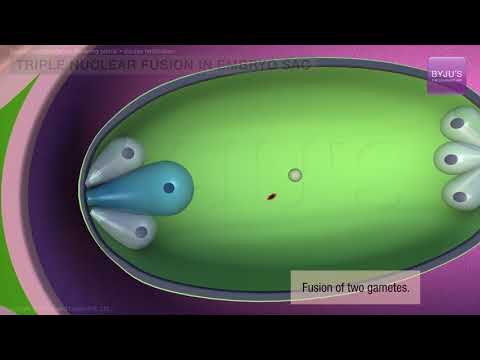In flowering plants or angiosperms, reproduction is attained by fertilization; more precisely double fertilization.
Read on to explore how to double fertilization is achieved and its significance.
Double Fertilization Definition
“Double fertilization is a complex process which involves the fusion of one female gametophyte with two male gametes”
What is Double Fertilization?
Double fertilization is a chief trait of flowering plants. In the phenomena, one female gamete unites with two male gametes. One of the male gametes fertilizes the egg resulting in the formation of a zygote and the other unites with 2 polar nuclei for the formation of an endosperm.
Double fertilization provides stimulus to the plant resulting in the ovarian development to fruits and the development of ovules into the seed. When the haploid male gametes and female gametes fuse, the diploid state of the plant is restored.
Double Fertilization Process
The process of double fertilization is explained below:
Double Fertilization in Angiosperms
Angiosperms are flower-bearing plants and are the most diverse group of terrestrial plants. The flowers form the reproductive part of angiosperms with separate male and female reproductive organs. Each contains gametes – sperm and egg cells, respectively.
Pollination helps the pollen grains to reach stigma via style. The two sperm cells enter the ovule-synergid cell. This proceeds to fertilization.
In angiosperms, fertilization results in two structures, namely, zygote and endosperm, hence the name “double fertilization.”
Double fertilization is a complex process where out of two sperm cells, one fuses with the egg cell and the other fuses with two polar nuclei which result in a diploid (2n) zygote and a triploid (3n) primary endosperm nucleus (PEN) respectively.
Since endosperm is a product of the fusion of three haploid nuclei, it is called triple fusion. Eventually, the primary endosperm nucleus develops into the primary endosperm cell (PEC) and then into the endosperm.
The zygote becomes an embryo after numerous cell divisions.
Also Read: Post Fertilization

Double Fertilization
Development of Embryo in Angiosperms
Once fertilization is completed, embryonic development starts and no more sperms can enter the ovary. The fertilized ovule develops into a seed, and ovary tissues develop a fleshy fruit which encloses the seed.
After fertilization, the zygote divides into the upper terminal cell and lower basal cell. The basal cell develops into suspensor, which helps in the transport of nutrients to the growing embryo. The terminal cell develops into pro-embryo.
Following are the different stages involved in the development of an embryo.
Stages of Embryonic Development In Angiosperms
- In the first stage of development, the terminal cell divides forming a globular pro-embryo. The basal cell also divides, into a suspensor.
- The developing embryo attains a heart shape due to the presence of cotyledons.
- The growing embryo gets crowded and begins to bend.
- The embryo fills the seed completely.

Significance of Double Fertilization
The significance of double fertilization is as follows:
- Two products are obtained as a result of double fertilization.
- There are chances of polyembryony, and the plant has better chances of survival.
- Double fertilization gives rise to an endosperm that provides nourishment to the developing embryo.
- It increases the viability of the seeds of angiosperms.
- It utilizes both the male gametes produced by the pollen grains.
Also Read: Angiosperms
To know more about double fertilization, its process and significance, keep visiting BYJU’S Biology.
Recommended Video:
Double Fertilisation & Post Fertilisation Events Class 12 – Reproduction in Flowering Plants

Frequently Asked Questions
What is double fertilization?
Double fertilization refers to the fusion of one female gametophyte with two male gametophytes.
What is the importance of double fertilization?
Double fertilization provides stimulus to the plant as the ovary develops into a fruit. Due to the fusion of male and female haploid gametes, a diploid zygote is formed. The zygote develops into an embryo, giving rise to a new plant.
What are the end products of double fertilization?
The end products of double fertilization are:
- Diploid Zygote
- Primary Endosperm Nucleus
Why is double fertilization absent in gymnosperms?
Gymnosperms are devoid of ovaries, and the male and female gametophytes are present on cones. Whereas, in angiosperms, the gametophytes are a part of the flower. Hence, pollination in gymnosperms occurs with the help of wind that blows the pollen to land on the female cones. That is why they do not exhibit double fertilization.
Who discovered double fertilization?
Double fertilization was discovered by Nawaschin in 1898 in liliaceous plants, Lilium martagon and Fritillaria tenella.
Describe the process of double fertilization.
Double fertilization is the characteristic of angiosperms. In this process, one male gamete fuses with the egg to form a zygote, which is known as syngamy. The other male gamete fuses with the two polar nuclei in the central cell to produce a triploid primary endosperm nucleus or PEN. This process is called triple fusion. Since fertilisation occurs twice, it is called double fertilisation.

It’s the best platform i have known
Yes it’s very good and superb
It is the best platform and it is very helpful
This is the best platform that helps me to understand the concepts
According to me Byjus is the best platform for learning, especially for PCB
Good app to learn the subjects